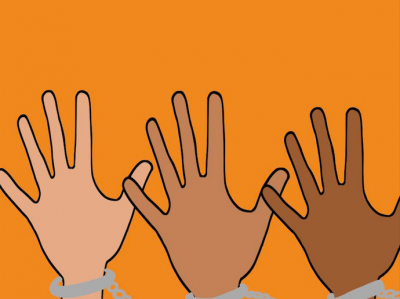The United States has a mass incarceration problem.
We imprison more people than any other country in the world. More than 2.1 million people were locked up in June 2020 — a 500 percent increase in incarceration rates compared to 40 years ago.

If these numbers seem astronomical and ridiculous to you, it’s because they are. You might look at these numbers and think to yourself, “Well, this just means crime rates are going up and we have to put more people in jail.”
Wrong. The increase in incarceration rates is largely due to targeted legislation, the War on Drugs and the political attitude of being “tough on crime.” In fact, crime rates — particularly violent crimes — have gone down since the 1990s and have continued to decrease since.
If you were to take a close look at crime rates over the last few decades, you would notice we are actually living in a time with some of the lowest violent crime rates in history, and yet nearly the highest incarceration rate ever — though it is important to note the incarceration rate saw a slight drop around 2011. You would also notice how those incarcerated for drug offenses are disproportionately people of color.
Black men are six times more likely to be arrested than a white man is. In fact, people of color make up 37 percent of the U.S. population but more than two-thirds of the prison population.
Another terrifying prison phenomenon is the sexual abuse to prison pipeline many female prisoners have experienced.
A large number of the women and girls who are incarcerated were not sent to prison or jail because they are committing harmful, violent crimes, according to a 2015 study conducted by the Human Rights Project for Girls, Georgetown Law Center on Poverty and Inequality and the Ms. Foundation for Women. Instead, these women were committing non-violent crimes that stemmed from abuse or trauma.

Girls are being arrested for behavior such as running away, skipping school or substance abuse — all indicators of a survivor of abuse or someone running from abuse. Sometimes they are arrested for prostitution, even when they are too young to consent to sex in the first place.
This study concluded that a large percentage of women being imprisoned are actually victims who need help rather than criminals who need reform.
The study also found that the girls and women falling victim to this pipeline are largely women of color. This is not surprising considering how people of color are overrepresented in the prison system, but it serves as yet another example of how society has failed Black and brown Americans.
Furthermore, the study argues that in the juvenile justice system, young girls are quickly becoming the most represented group, and many of them are survivors of sexual assault and harassment prior to entering the justice system.
Unfortunately, we don’t talk about this issue often enough. Girls are suffering and then being punished for the ways in which they act out. Moreover, these severe punishments could unnecessarily affect the rest of their lives and destroy future career prospects.
It is time that our country stops throwing everyone who commits petty crimes in jail because, in a lot of instances, the mistake is indicative of a larger systemic problem rather than the fault of the individual. One mistake should not define your entire life. Instead, getting these people the help they need is more productive, effective and rehabilitative.
Additionally, no underage girl should ever be sentenced to jail for prostitution because they are definitely the victim in that instance. How can you put someone behind bars for an act they cannot legally consent to and for something they were illegally trafficked into?
People deserve second chances, support and help. So many of these girls could lead prosperous lives if they are just given the help they need to work through the trauma and abuse they have experienced.
It is time our country gets its humanity back and starts to rehabilitate rather than incarcerate.























































































































Andrew Albers • Mar 6, 2021 at 8:04 am
I agree.